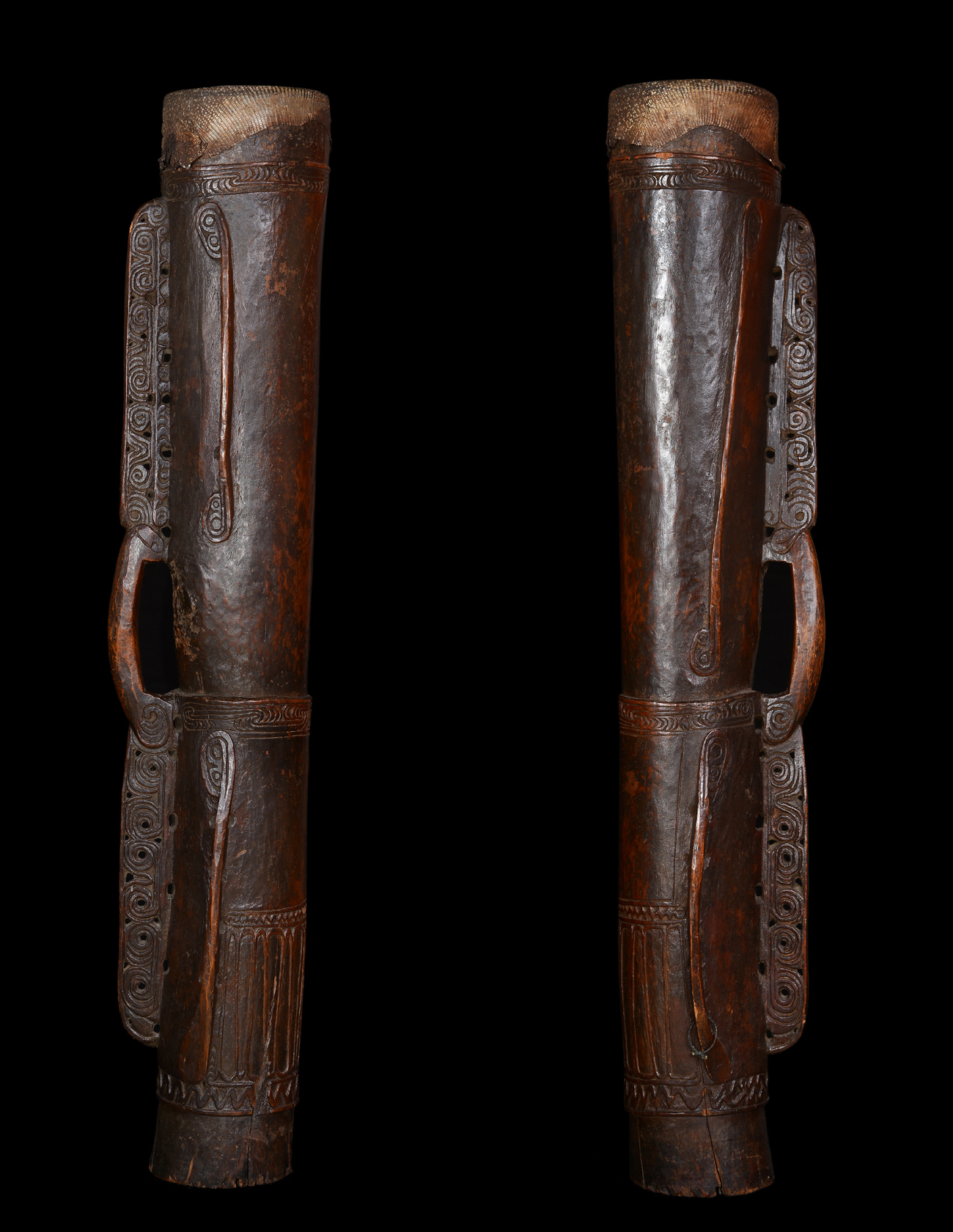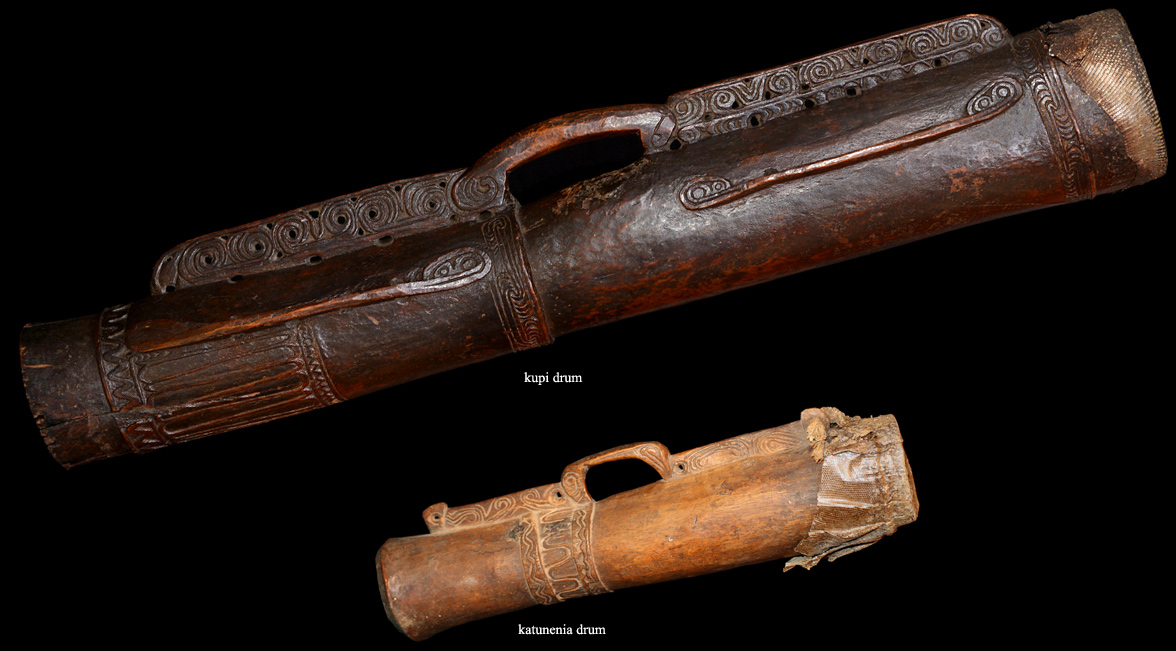DRUMS OF THE WORLD
New Guinea
pre contact Massim drum New Guinea
Pre contact - stone carved Massim drum (kupi) Papua New Guinea / Trommel Papua Neuguinea. Trobriand Islands, Milne Bay Province.
Trobriand drums are carved from heavy kwila wood. They are used for dances and sometimes just to beat out a rhythm.
"The drums (...) consist of: (1) the large drum called kasausa'u or kupi (this latter word being an obscene synonym for the glans penis): and (2) the small drum, about one third the size of the larger, called katunenia. All their drumbeats are a combination of the two drums, the kupi and the katunenia leading each its separate voice. There are two main types of dance in Boiowa. The circular dances, where the orchestra (the drums and the singers) stands in the middle, and the performers go round them in a circle, always in the opposite direction to the hands of a watch. These dances are again subdivided into: (1) bisila (pandanus streamer) dances with slow movement,(2) kitatuva (two bunches of leaves), with a quick movement; and (3) kaidebu (wooden painted shield), dances with the same quick movement. In the bisila dances women can take part (very exceptionally), and all the performers wear women's petticoats. The second group of dances are the kasawaga, where only three men dance, always in imitation of animal movements, though these are very conventionalized and unrealistic. These dances are not circular, there are no songs (as a rule) to accompany them; the orchestra consists of five kupi drums and one katunenia."
Malinowski, Bronislaw (1916) : Baloma - the Spirits of the Dead in the Trobriand Islands.
"Bij de traditionele dansen waarbij de mannen in een cirkel tegen de klok in dansen staan de trommelaars en zangers in het midden van de kring. Andere dansen zijn de dansen waarbij drie mannen een dier uitbeelden, en de modernere ontwikkelingen van dansen waarbij de dansers in rijen achter elkaar staan, zoals bij cricket wedstrijden of bij optredens voor toeristen. Voor alle ritmes worden de twee soorten trommels altijd in combinatie met elkaar gebruikt met ieder een eigen stem (Malinowski in Young, 1989:93/97). De lange trommen worden met meerdere vingers bespeeld, de kleinere slechts met een vinger (Norick, 1976:209). Malinowski (1930:29) beschrijft een opvallend gebruik in verband met Trobriand trommels. Op de ochtend voordat de oogstfeesten beginnen moet het taboe op de trommels in een eigen ritueel worden opgeheven. De dansers treden in vol ornaat op met de zangers en trommelaars. Maar het trommen is van korte duur want de vrouwen uit het dorp die nog in rouw zijn beginnen bij de eerste trommelslagen al snel hevig te wenen en van achter de huizen komt een menigte schreeuwende vrouwen te voorschijn die de mannen met stokken slaan en met stenen en kokosnoten bekogelen. Volgens het ritueel moeten de mannen snel vertrekken achtervolgd door de vrouwen, een leeg dorp achterlatend. Daarmee is het taboe gebroken, op de zelfde middag begint het oogstfeest met de eerste volledige dansuitvoering."
copyright: collectie@wereldculturen.nl - http://collectie.wereldculturen.nl/#/query/3225a1d2-a3e9-430e-a0b4-b6fcfaef9bfe
Bibliography:
Beran, Harry (1980) : Massim Tribal Art. Wollongong - Wollongong City Gallery.
Hamson, Michael and Richard Aldridge. (2009) : Art of the Massim & Collingwood Bay. Palos Verdes Estates, Cal.: Michael Hamson Oceanic Art.
Malinowski, Bronislaw (1930): Das Geschlechtsleben der Wilden, Leipzig und Zürich.
Malinowski, Bronislaw (1916) : Baloma - the Spirits of the Dead in the Trobriand Islands.
Newton, Douglas (1975) : Massim - Art of the Massim Area - New Guinea. New York : The Museum of Primitive Art.
Norick, Frank Albert (1976) : An analysis of the material culture of the Trobriand Islands based upon the collection of Bronislaw Malinowski, Ann Arbor, Michigan and London. University Microfilms International.
Finsch, Otto (1888) : Reisen in Kaiser Wilhelms-Land und Neu-Guinea an Bord des Dampfers Samoa.
Finsch, Otto (1888) : Ethnologische Erfahrungen und Belegstücke aus der Südsee - beschreibender Katalog einer Sammlung im K.K. Naturhistorischen Hofmuseum in Wien.
Trobriand drums are carved from heavy kwila wood. They are used for dances and sometimes just to beat out a rhythm.
"The drums (...) consist of: (1) the large drum called kasausa'u or kupi (this latter word being an obscene synonym for the glans penis): and (2) the small drum, about one third the size of the larger, called katunenia. All their drumbeats are a combination of the two drums, the kupi and the katunenia leading each its separate voice. There are two main types of dance in Boiowa. The circular dances, where the orchestra (the drums and the singers) stands in the middle, and the performers go round them in a circle, always in the opposite direction to the hands of a watch. These dances are again subdivided into: (1) bisila (pandanus streamer) dances with slow movement,(2) kitatuva (two bunches of leaves), with a quick movement; and (3) kaidebu (wooden painted shield), dances with the same quick movement. In the bisila dances women can take part (very exceptionally), and all the performers wear women's petticoats. The second group of dances are the kasawaga, where only three men dance, always in imitation of animal movements, though these are very conventionalized and unrealistic. These dances are not circular, there are no songs (as a rule) to accompany them; the orchestra consists of five kupi drums and one katunenia."
Malinowski, Bronislaw (1916) : Baloma - the Spirits of the Dead in the Trobriand Islands.
"Bij de traditionele dansen waarbij de mannen in een cirkel tegen de klok in dansen staan de trommelaars en zangers in het midden van de kring. Andere dansen zijn de dansen waarbij drie mannen een dier uitbeelden, en de modernere ontwikkelingen van dansen waarbij de dansers in rijen achter elkaar staan, zoals bij cricket wedstrijden of bij optredens voor toeristen. Voor alle ritmes worden de twee soorten trommels altijd in combinatie met elkaar gebruikt met ieder een eigen stem (Malinowski in Young, 1989:93/97). De lange trommen worden met meerdere vingers bespeeld, de kleinere slechts met een vinger (Norick, 1976:209). Malinowski (1930:29) beschrijft een opvallend gebruik in verband met Trobriand trommels. Op de ochtend voordat de oogstfeesten beginnen moet het taboe op de trommels in een eigen ritueel worden opgeheven. De dansers treden in vol ornaat op met de zangers en trommelaars. Maar het trommen is van korte duur want de vrouwen uit het dorp die nog in rouw zijn beginnen bij de eerste trommelslagen al snel hevig te wenen en van achter de huizen komt een menigte schreeuwende vrouwen te voorschijn die de mannen met stokken slaan en met stenen en kokosnoten bekogelen. Volgens het ritueel moeten de mannen snel vertrekken achtervolgd door de vrouwen, een leeg dorp achterlatend. Daarmee is het taboe gebroken, op de zelfde middag begint het oogstfeest met de eerste volledige dansuitvoering."
copyright: collectie@wereldculturen.nl - http://collectie.wereldculturen.nl/#/query/3225a1d2-a3e9-430e-a0b4-b6fcfaef9bfe
Bibliography:
Beran, Harry (1980) : Massim Tribal Art. Wollongong - Wollongong City Gallery.
Hamson, Michael and Richard Aldridge. (2009) : Art of the Massim & Collingwood Bay. Palos Verdes Estates, Cal.: Michael Hamson Oceanic Art.
Malinowski, Bronislaw (1930): Das Geschlechtsleben der Wilden, Leipzig und Zürich.
Malinowski, Bronislaw (1916) : Baloma - the Spirits of the Dead in the Trobriand Islands.
Newton, Douglas (1975) : Massim - Art of the Massim Area - New Guinea. New York : The Museum of Primitive Art.
Norick, Frank Albert (1976) : An analysis of the material culture of the Trobriand Islands based upon the collection of Bronislaw Malinowski, Ann Arbor, Michigan and London. University Microfilms International.
Finsch, Otto (1888) : Reisen in Kaiser Wilhelms-Land und Neu-Guinea an Bord des Dampfers Samoa.
Finsch, Otto (1888) : Ethnologische Erfahrungen und Belegstücke aus der Südsee - beschreibender Katalog einer Sammlung im K.K. Naturhistorischen Hofmuseum in Wien.


